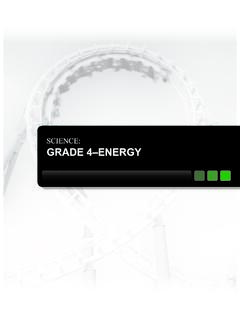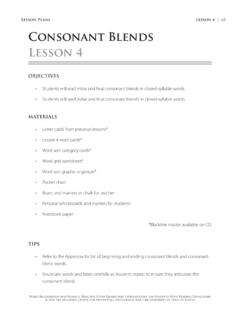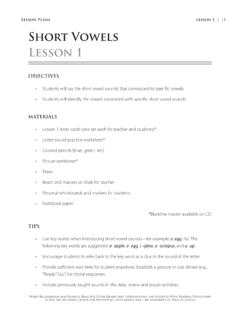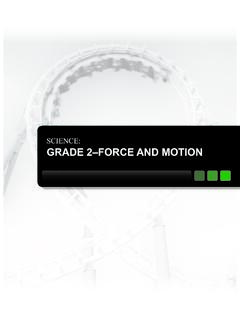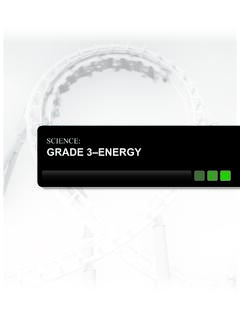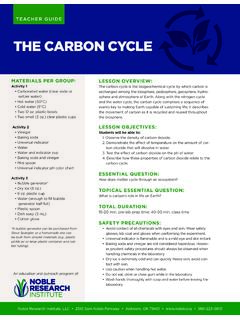Transcription of SCIENCE: GRADE 4–FORCE AND MOTION
1 SCIENCE: GRADE 4 FORCE AND MOTION388 GRADE 4 Force and MotionEffects of ForceTEKS4 (6) Force, MOTION , and energy. The student knows that energy exists in many forms and can be observed in cycles, patterns, and systems.(D) The student is expected to design an experiment to test the effect of force on an object such as a push or a pull, gravity, friction, or magnetism. ScienceScience Process Skills4 (2) Scientific investigation and reasoning. The student uses scientific inquiry methods during laboratory and outdoor investigations.(A) The student is expected to plan and implement descriptive investigations, including asking well-defined questions, making inferences, and selecting and using appropriate equipment or technology to answer his/her questions.
2 (B) The student is expected to collect and record data by observing and measuring, using the metric system, and using descriptive words and numerals such as labeled drawings, writing, and concept maps.(C) The student is expected to construct simple tables, charts, bar graphs, and maps using tools and current technology to organize, examine, and evaluate data.(D) The student is expected to analyze data and interpret patterns to construct reasonable explanations from data that can be observed and measured.(E) The student is expected to perform repeated investigations to increase the reliability of results.(F) The student is expected to communicate valid oral and written results supported by ObjectiveI can design an experiment to test the effects of force on an object.
3 2012 TEXAS EDUCATION AGENCY. ALL RIGHTS 4 Force and Motion4 (4) Scientific investigation and reasoning. The student knows how to use a variety of tools, materials, equipment, and models to conduct science inquiry.(A) The student is expected to collect, record, and analyze information using tools, including calculators, microscopes, cameras, computers, hand lenses, metric rulers, Celsius thermometers, mirrors, spring scales, pan balances, triple beam balances, graduated cylinders, beakers, hot plates, meter sticks, compasses, magnets, collecting nets, and notebooks; timing devices, including clocks and stopwatches; and materials to support observation of habitats of organisms such as terrariums and (11) Measurement.
4 The student applies measurement concepts. The student is expected to estimate and measure to solve problems involving length (including perimeter) and area. The student uses measurement tools to measure capacity/volume and weight/mass.(A) The student is expected to estimate and use measurement tools to determine length (including perimeter), area, capacity and weight/mass using standard units SI (metric) and Language Arts and Reading4 (27) Listening and speaking/listening. Students use comprehension skills to listen attentively to others in formal and informal settings. Students continue to apply earlier standards with greater complexity.
5 (A) Students are expected to listen attentively to speakers, ask relevant questions, and make pertinent (28) Listening and speaking/speaking. Students speak clearly and to the point, using the conventions of language. Students continue to apply earlier standards with greater complexity. Students are expected to express an opinion supported by accurate information, employing eye contact, speaking rate, volume, and enunciation, and the conventions of language to communicate ideas (29) Listening and speaking/teamwork. Students work productively with others in teams. Students continue to apply earlier standards with greater complexity.
6 Students are expected to participate in teacher - and student-led discussions by posing and answering 390 GRADE 4 Force and MotionEnglish Language Proficiency Standards1 (E) Cross-curricular second language acquisition/learning student is expected to internalize new basic and academic language by using and reusing it in meaningful ways in speaking and writing activities that build concept and language ObjectiveI can use the appropriate vocabulary to describe an with appropriate detail and by providing suggestions that build upon the ideas of 19. Reading/comprehension skills. Students use a flexible range of metacognitive reading skills in both assigned and independent reading to understand an author s message.
7 Students will continue to apply earlier standards with greater depth in increasingly more complex texts as they become self-directed, critical readers. (C) The student is expected to monitor and adjust comprehension ( , using background knowledge, creating sensory images, re-reading a portion aloud, generating questions).(D) The student is expected to make inferences about text and use textual evidence to support understanding. 2012 TEXAS EDUCATION AGENCY. ALL RIGHTS 4 Force and MotionResponse to Intervention/Tier 1 DifferentiationAll science lessons support students in receiving quality Tier 1 instruction. Using the 5E model, knowledge is taught in a variety of contexts, integrating math, science, and ELA content, thus supporting the active engagement of students with the content.
8 Lesson-specific differentiation strategies for addressing diverse student needs can be found throughout each lesson in sections titled Differentiation Strategy. Differentiation should focus on skills students did not understand and extend the lesson for advanced students; be conducted in small groups or embedded in whole-group instruction; and provide students with a variety of strategies to process the information, such as -allowing for additional opportunities for verbal brainstorming of words associated with a topic (with teacher taking dictation); -making clear connections of new and more complex concepts to foundational aspects and prior knowledge; -participating in more tangible experiences, such as experiments, investigations, and active exploration.
9 -sorting academic vocabulary words into categories by common attributes process words or science content vocabulary; -organizing brainstorming into semantic maps or creating graphic organizers; -discussing the meaning of a graphic organizer with a partner; and -creating a visual representation to demonstrate the handout in the Content Resources section that addresses instructional and Career Readiness Cognitive skills in science. Rely on reproducible observations of empirical evidence when constructing, analyzing, and evaluating explanations of natural events and Scientific inquiry. Design and conduct scientific investigations in which hypotheses are formulated and 4 Force and MotionPrerequisite Science KnowledgeK (6)(B) The student is expected to explore interactions between magnets and various (6)(B) The student is expected to predict and describe how a magnet can be used to push or pull an (6)(B) The student is expected to observe and identify how magnets are used in everyday (6)(B) The student is expected to demonstrate and observe how position and MOTION can be changed by pushing and pulling objects to show work being done such as swings, balls, pulleys, and (6)(C)
10 The student is expected to observe forces such as magnetism and gravity acting on Lesson SummaryEngage Students observe the effects of Students test the effects of different Students explain different forces and how an experiment is designed to test the effects of Students design their own experiments to test Students assess whether an experiment was properly designed and if it produced reliable Focusforcefrictiongravitymagnetismobject 2012 TEXAS EDUCATION AGENCY. ALL RIGHTS 4 Force and MotionEngageTeacher NoteStudents may or may not know about the force of friction. This activity addresses friction without defining it.
